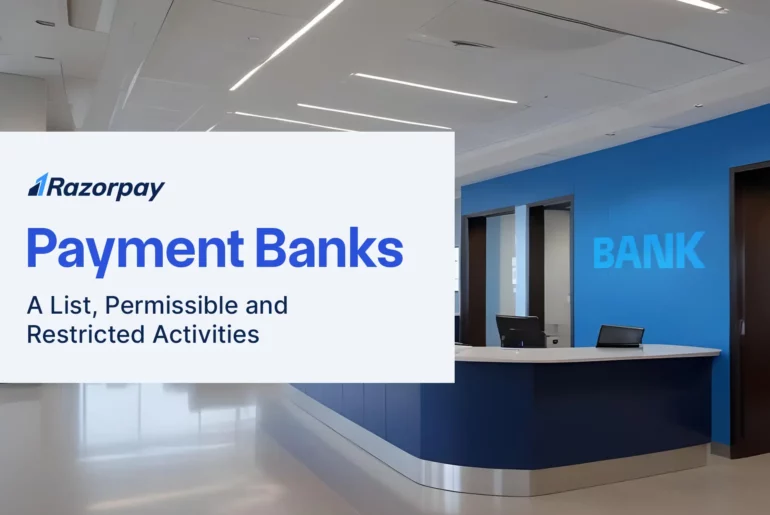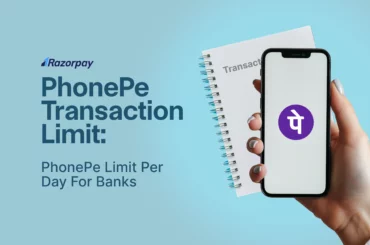Payment banks are designed to deliver accessible and affordable banking services to underserved segments of society, including low-income households, small businesses, and migrant workers. These banks focus on financial inclusion by providing essential services that traditional banks might not offer to these groups. In this article, we will define what a payment bank is, explore how it operates, and highlight the top payment banks in India in 2025.
Table of Contents
What Are Payment Banks?
Payment banks are specialized financial institutions designed to provide basic banking services to the underbanked and unbanked population. They offer a limited range of products and services, focusing on facilitating financial transactions and promoting financial inclusion.
Unlike traditional banks, payment banks cannot issue loans or credit cards. Their primary function is to provide safe and convenient access to banking services, such as deposits, withdrawals, remittances, and payments, primarily through digital channels.
Features of Payment Banks
Some of the key features of payment banks are:
Payment banks offer a range of basic financial services to the underbanked and unbanked population. Key features include:
Deposit Accounts
Customers can open savings and current accounts with a maximum balance limit of ₹200,000.
Debit Cards
Payment banks issue debit cards for ATM withdrawals and POS transactions.
Money Transfers
Facilitate domestic and international bank transfers of funds through various modes, such as NEFT (national electronic fund transfer), IMPS (immediate payment service), UPI (unified payments interface), and AEPS (Aadhaar-enabled payment systems).
Mobile Banking
Offering convenient banking services through mobile apps, including balance inquiries, fund transfers, and bill payments.
Agent banking
Expanding reach through a network of business correspondents in rural and semi-urban areas.
Basic Financial Services
Providing essential services like utility bill payments, mobile recharges, and insurance products.
Investment Restrictions
Funds are primarily invested in government securities with a maturity period of up to one year.
Leverage of Technology
Employing biometric authentication, QR codes, and NFC technology to enhance security and convenience for customers.
Partnerships and Collaborations
Payment banks collaborate with financial institutions and service providers to offer a wider range of financial products, such as insurance, mutual funds, and pensions, enhancing their service offerings.
List of Payment Banks in India (2025)
Below is a list of some popular payment banks in India:
Payment Bank |
Established Name |
Headquarters |
Unique Features |
| Airtel Payments Bank | Bharti Airtel Limited | New Delhi | First payment bank to launch in India (January 2017), extensive network of over 500,000 banking points through Airtel retail outlets, offers 2.5% interest rate on savings accounts and free personal accident insurance cover of Rs. 1 lakh. |
| Paytm Payments Bank | One97 Communications Limited | Noida | Integration with Paytm app, over 350 million registered users, offers 2.5% interest rate on savings accounts, cashback, and transaction rewards. |
| India Post Payments Bank | Department of Posts | New Delhi | Leveraging post office network, focus on rural and low-income segments, offers a range of financial services beyond banking. |
| Fino Payments Bank | Fino Paytech Limited | Mumbai | Strong presence in rural and low-income segments (accounts for 70% of its customer base), offers 5% interest rate on savings accounts, micro ATM, doorstep banking. |
| Jio Payments Bank | Reliance Jio | Mumbai | Integration with Jio ecosystem, potential for large user base due to telecom network, focus on digital payments and financial services. |
| NSDL Payments Bank | National Securities Depository Limited | Mumbai | Technology-driven approach, backed by the National Securities Depository Limited, offers financial market-linked products and services. |
What are the Permissible Activities of Payment Banks?
Payment banks are designed to provide essential banking services to underserved populations. Here are the key permissible activities they can engage in:
Accepting Deposits
Payment banks can accept deposits from individuals, small businesses, and other entities, with a maximum limit of ₹2 lakh per customer.
Facilitating Money Transfers
They enable quick and secure money transfers, both domestically and internationally, providing a vital service for migrant workers and others who need to send money across borders.
Issuing Prepaid Instruments
Payment banks can issue prepaid instruments, such as debit cards and mobile wallets, allowing customers to make cashless transactions conveniently.
Offering Basic Financial Services
Customers can open savings accounts, current accounts, fixed deposits, and recurring deposits with payment banks, enjoying attractive interest rates and minimal charges.
Distributing Third-Party Products
Payment banks can distribute third-party financial products, including insurance, mutual funds, pensions, and government schemes, expanding their service offerings to meet customers’ diverse needs.
Acting as Business Correspondents
In remote areas, payment banks can serve as business correspondents for other banks, providing essential banking services where traditional banks may not be present.
Benefits for Customers in Remote Areas
Secure Deposits:
Customers can deposit funds securely and earn interest on their savings, even in areas where traditional banks are scarce.
Convenient Money Transfers:
The ability to transfer money quickly and at low cost is crucial for those supporting family members or conducting business across distances.
Access to Cash and Payments:
With net banking, mobile banking, or debit cards, customers can access cash and make payments anytime, anywhere, without the need for intermediaries.
Comprehensive Financial Solutions:
Payment banks offer a range of products and services, from savings accounts to insurance, catering to the financial needs of customers.
Financial Literacy Programs:
Payment banks, often in collaboration with their partners, conduct financial literacy and awareness programs, helping customers make informed financial decisions.
What are the Restricted Activities of Payment Banks?
Payment banks are subject to specific restrictions to ensure they remain focused on their core mission of providing basic banking services. Some of these restricted activities include:
Deposit Limitations
Payment banks cannot accept deposits exceeding ₹2 lakh per customer.
Prohibition on Lending
They are not allowed to extend loans or issue credit cards, ensuring they do not engage in high-risk credit activities.
No NRI Deposits
Payment banks cannot accept deposits from Non-Resident Indians (NRIs), limiting their customer base to residents.
Restrictions on Investments
Establishing subsidiaries, forming joint ventures, or investing in other entities requires prior approval from the Reserve Bank of India (RBI).
Prohibited Activities
Any activities not explicitly permitted by the RBI or the government are restricted, keeping the operations of payment banks streamlined and focused.
Reasons Behind These Restrictions
Financial Stability:
The restrictions help prevent payment banks from growing too large and posing systemic risks to the banking sector and the broader economy.
Risk Management:
By avoiding lending and investment activities, payment banks are protected from credit, market, and operational risks that could compromise their stability.
Security and Compliance:
These limitations help safeguard payment banks from becoming conduits for money laundering, terrorist financing, fraud, and other illegal activities, preserving their reputation and trustworthiness.
Focused Innovation:
The constraints encourage payment banks to innovate within their niche of small-scale deposits and payment services, rather than competing in the broader and more crowded lending market.
History of Payment Banks
The concept of payment banks first gained prominence in Kenya with Safaricom’s 2007 launch of M-Pesa. This mobile money storage and transfer service allowed users to store and transfer money. Following Kenya’s lead, several countries, including Bangladesh, Nigeria, Brazil, and Indonesia, have embraced the concept.
Development of Payment Banks in India:
- India introduced payment banks as part of its efforts to promote financial inclusion.
- In 2014, the Nachiket Mor committee proposed two types of differentiated banks, namely payment banks and small finance banks.
- The RBI published guidelines for licensing of payment banks in 2014 and approved 11 entities, out of which six started operations.
- These six banks are Airtel Payments Bank, Paytm Payments Bank, India Post Payments Bank, Fino Payments Bank, Jio Payments Bank, and NSDL Payments Bank.
Benefits of Payment Banks
- Expands Banking Access in Rural Areas – Helps cover gaps in underserved locations.
- Promotes Digital & Organised Finance – Pushes for cashless transactions.
- Serves as an Option to Traditional Banks – Efficient for small-value dealings.
- Ensures Fund Safety – Investments limited to government-secured instruments.
- Lessens Cash-Based Transactions – Promotes digital usage instead.
Issues Faced by Payment Banks
- Limited Public Awareness – Rural users are often unaware of available services.
- Low Earnings for Agents – Smaller commissions reduce motivation.
- Weak Infrastructure – Needs better network and service availability.
- Tech Challenges – Digital skills and security fears limit adoption.
What is the Difference Between a Normal Bank and a Payment Bank?
Payment banks and traditional commercial banks share some similarities but differ significantly in terms of their scope and services offered.
Key Differences:
- Product offerings: Commercial banks offer a wide range of financial products, including loans, credit cards, investment products, and insurance, while payment banks are restricted to basic banking services like deposits, withdrawals, remittances, and payments.
- Deposit limits: Payment banks have a maximum deposit limit per customer, whereas commercial banks have no such restrictions.
- Investment restrictions: Payment banks primarily invest in government securities, while commercial banks have a broader investment portfolio.
- Loan services: Commercial banks offer various loan products, including personal loans, home loans, and business loans, while payment banks cannot provide any form of credit.
- Branch network: Commercial banks typically have a larger and more extensive branch network compared to payment banks, which often rely on agent banking for wider reach.
Regulations Under Payment Banks
The regulatory framework governing payment banks consists of the following elements:
- Licensing Requirements: The RBI issues licenses to eligible entities, such as telecom companies, non-banking finance companies, prepaid payment instrument issuers, and others, subject to certain conditions and criteria.
- Guidelines: The payment banks must maintain a minimum paid-up equity capital of Rs.100 crore, have at least 51% of their shareholding owned by Indian residents, have a diversified board of directors, and adhere to corporate governance and prudential norms.
- Supervision: The RBI supervises the operations, performance, compliance, and risk management of payment banks through periodic reporting, inspection, audit, and review. The RBI additionally has the power to impose penalties, cancel licenses, or take other corrective action in case of any violation or irregularity by the payment banks.
Latest Updates on Payments Banks
The RBI may revise or amend the regulations governing payment banks from time to time based on the industry’s feedback, experience, and developments. Some of the recent updates or changes in regulations affecting payment banks are:
-
- In August 2019, the RBI increased the maximum balance limit for payment bank customers from Rs. 1 lakh to Rs. 2 lakh to encourage more savings and deposits in payment banks.
- In September 2019, the RBI allowed payment banks to apply for small finance bank licenses after completing five years of operations to enable them to offer diverse products and services, such as lending and credit.
- In October 2019, the RBI permitted payment banks to become authorised dealers in foreign exchange to facilitate cross-border customer remittances and transactions.
- In February 2020, the RBI issued a draft circular on the guidelines for on-tap licensing of payment banks to encourage more entities to enter the space and foster competition and innovation in the sector.
Frequently Asked Questions
1) Who introduced the payment bank?
The Reserve Bank of India (RBI) conceptualized payment banks in 2014 to provide essential banking services to the unbanked or underbanked population.
2) What is the main purpose of payment banks?
The main purpose of payment banks is to enable financial inclusion by offering savings accounts, current accounts, mobile banking, and remittance services to low-income households and small businesses.
3) Which is the first payment bank in India?
The first payment bank in India was Airtel Payments Bank, launched by Bharti Airtel in January 2017.
4) How do payment banks collaborate with traditional banks and technology companies?
Payment banks collaborate with traditional banks and technology companies by acting as business correspondents, offering co-branded products, leveraging digital platforms, and integrating with existing payment systems.
5) How do payment banks ensure the security of digital transactions?
Payment banks use biometric authentication, encryption, fraud detection, and customer awareness to ensure the security of digital transactions.




